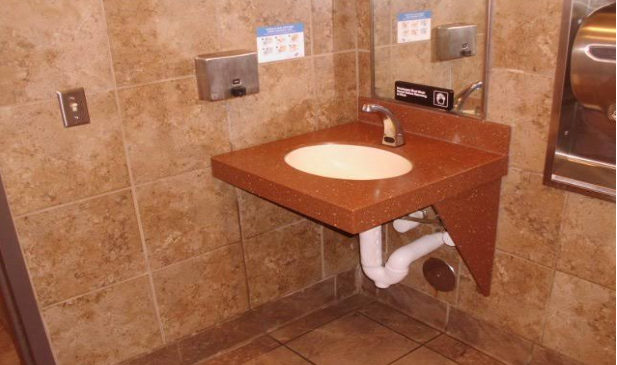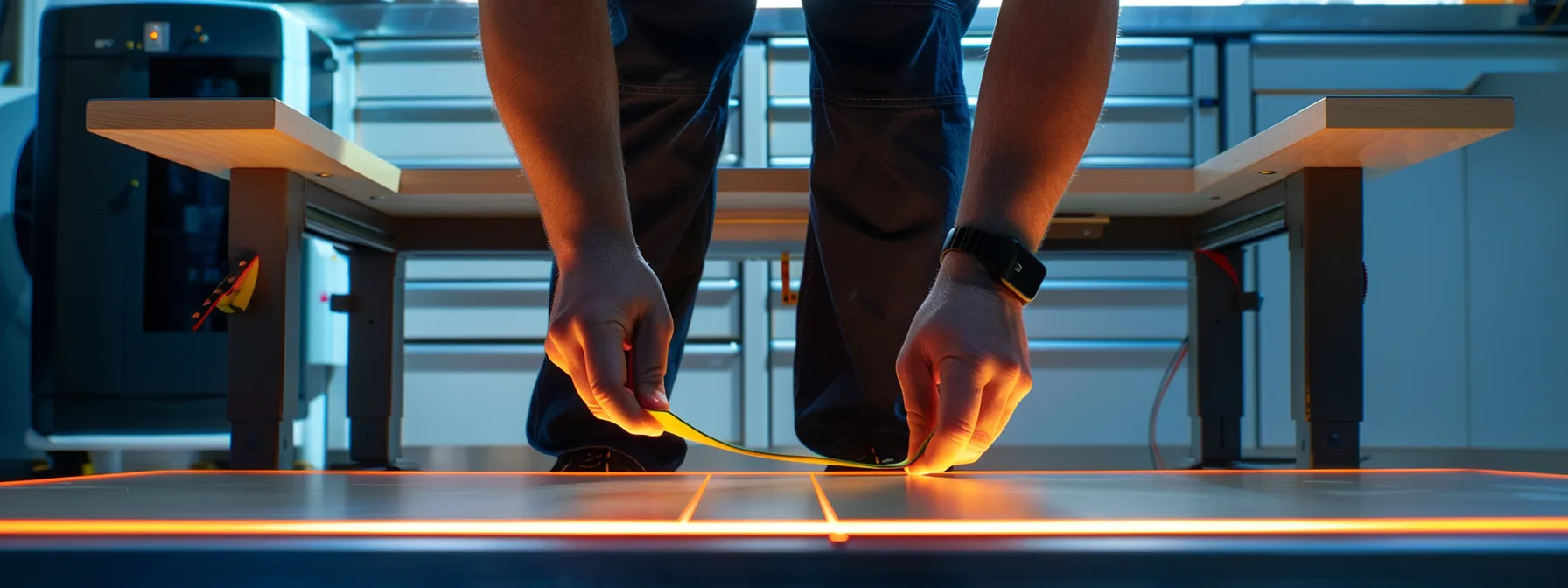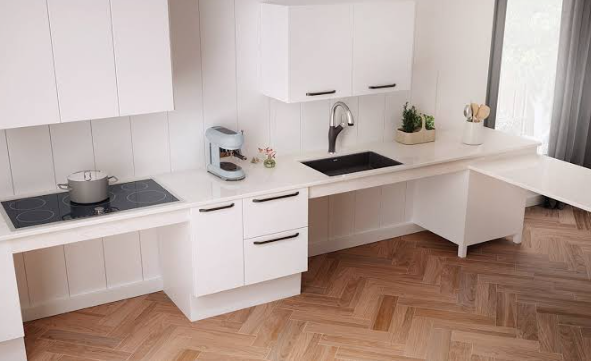
Mastering ADA compliance is crucial for ensuring accessibility within buildings, particularly when it comes to ada knee clearance. The Americans with Disabilities Act of 1990 mandates specific requirements to accommodate individuals with disabilities while also allowing for the preservation of historic structures. Understanding these regulations is fundamental for architects, builders, and anyone involved in property management. Assessing knee clearance not only ensures compliance but also fosters inclusivity in spaces used by people of all abilities. Exploring the significance of adequate knee clearance will equip stakeholders with the tools necessary to navigate compliance in both new constructions and renovations. Keep reading to discover a comprehensive checklist that will assist in achieving and maintaining ADA standards.

Understanding knee clearance requirements is vital for ensuring compliance with the ADA guidelines ada knee clearance. These regulations set minimum knee clearance measurements, which must be adhered to in various spaces, including elevators, aisles, and near bus stops, to promote accessibility. Proper knee clearance helps eliminate discrimination against individuals with mobility challenges, allowing them to maneuver comfortably in public areas and facilities, such as those adjacent to a pier. Recognizing the importance of these requirements is essential in creating an inclusive environment for all.
The ADA guidelines stipulate specific requirements for knee clearance in various environments, including properties utilizing curb cuts for accessibility. Proper measurements must account for features such as sinks and other fixtures that could impede maneuverability. Adhering to these standards during construction ensures that all individuals can navigate spaces safely and comfortably, especially near vehicles and public transport areas.
The law mandates specific minimum knee clearance measurements to ensure compliance with ADA regulations, vital for promoting accessibility in various settings. These standards apply not only to public spaces but also to employment environments where individuals may need to interact with workstations at floor level. A comprehensive checklist can assist in verifying that these measurements meet regulatory expectations, fostering an inclusive atmosphere conducive to all users.
Knee clearance holds significant importance in creating accessible rooms and public spaces. A proper inspection of areas around fixed furniture and equipment ensures that individuals can navigate freely without obstructions. Moreover, ensuring appropriate clearance can play a critical role during emergency evacuation, allowing for swift movement across the finish floor in urgent situations.
| Aspect | Description |
|---|---|
| Importance | Facilitates ease of movement for individuals with mobility challenges. |
| Inspection | Regular checks ensure compliance with knee clearance requirements. |
| Fixed Obstacles | Clearance must account for any fixed features within a room. |
| Emergency Evacuation | Ensures safe and rapid movement during critical situations. |
| Finish Floor | Design considerations around the finish floor level are crucial for accessibility. |
With a clear understanding of knee clearance requirements, the focus now shifts to practical application. Assessing your space for compliance can make a significant difference in accessibility and inclusivity.

Assessing a space for knee clearance compliance involves a systematic approach to ensure health care facilities and other environments meet established accessibility standards. This process includes evaluating existing structures for adequate knee and toe clearance, utilizing specific tools and methods to obtain accurate measurements. Understanding common obstacles that may impede compliance, such as furniture placement or architectural features, also plays a crucial role. Organizations can create a thorough document outlining their findings and recommendations, thereby fostering an environment that promotes general accessibility for all users.
To effectively evaluate existing structures for knee clearance, one must consider the placement of doors and fixtures such as grab bars. Ensuring that there is sufficient space—at least 27 inches of clearance beneath counters and other surfaces—can facilitate reasonable accommodation for patients with mobility needs. This assessment allows facilities to provide safe and accessible environments, promoting inclusivity for all users.
A variety of tools and methods exist for measuring knee and toe clearance in diverse settings, including correctional facilities like prisons. Measuring tools, such as tape measures and laser distance meters, can readily ensure that adequate space is available beneath counters or urinals. It is vital to assess these areas thoughtfully, particularly for emergency considerations where quick access is necessary, especially in confined spaces like a cell.
| Measurement Tool | Purpose |
|---|---|
| Tape Measure | Provides accurate measurements of knee and toe clearance space. |
| Laser Distance Meter | Offers precise and quick readings in hard-to-reach areas. |
| Clearance Templates | Helps visualize and check for compliance in fixed spaces. |
| Checklists | Guides the evaluation process to ensure thorough assessment. |
Identifying common obstacles to knee clearance compliance requires a detailed examination of various elements within a space. For instance, the height of drinking fountains and the distance of showers from walls can significantly impact accessibility. Landlords must ensure that curb designs do not obstruct pathways, enabling individuals with mobility challenges to navigate freely throughout the area.
Understanding the importance of knee clearance opens the door to better design choices. Let’s explore the key areas where maintaining this clearance becomes essential for safety and comfort.

Crucial to ensuring ADA compliance, particularly for Americans with disabilities, is the understanding of knee clearance requirements across various environments. For workspaces and counters, meeting specific dimensions is vital for employees who require accessible arrangements. In bathrooms and sanitary facilities, tailored designs can significantly enhance user experience and functionality. Public and commercial facilities also face unique challenges in adhering to building codes, which highlight the importance of a comprehensive ADA compliance checklist. By focusing on these key areas, organizations can create more inclusive spaces that meet the needs of all individuals, facilitating smoother navigation and greater independence.
Understanding requirements for workspaces and counters is vital for ensuring accessibility, especially for individuals using wheelchairs. Proper knee clearance accommodates maneuverability around elements such as handrails and elevators while ensuring safe interaction with devices like the fire alarm system. Additionally, appropriate design considerations for bathing facilities and close proximity to stairs can enhance usability for everyone, promoting an inclusive environment.
Bathrooms and sanitary facilities must adhere to specific ADA regulations to ensure accessibility for all users, including those with mobility challenges and visual impairment. Clear floor space is essential, allowing sufficient knee clearance for wheelchair users to maneuver comfortably while providing an unobstructed path to fixtures such as sinks and toilets.
Ensuring ADA compliance in public and commercial facilities includes a critical focus on various accessibility aspects, such as proper knee clearance around points of user interaction. For instance, detailed attention must be given to the layout of parking space access routes leading to entrances, allowing individuals with mobility challenges to enter buildings safely and comfortably. Such considerations not only comply with regulations but also enhance overall functionality and user experience.
Recognizing the critical need for knee clearance sets the stage for effective solutions. Now, let’s explore practical strategies to ensure ample knee space in various environments.

Implementing effective solutions for knee clearance involves a series of practical adjustments that enhance accessibility for individuals with mobility challenges. Selecting compliant furniture and fixtures serves as a crucial step in ensuring that spaces meet ADA requirements while maximizing usability. Attention to design can significantly improve maneuverability, allowing for better flow and interaction within public and private areas. Organizations can benefit from strategic planning that focuses on optimizing available space, ultimately fostering an inclusive environment that accommodates everyone’s needs without compromising functionality.
Improving knee clearance requires thoughtful adjustments to existing furniture and fixtures throughout the environment. For instance, selecting lower profile furniture or incorporating adjustable height features can significantly enhance accessibility, allowing individuals to navigate spaces more freely. Clear labeling and visual cues can further assist users in identifying accessible areas, ultimately promoting better mobility.
Here are several practical solutions to consider in enhancing knee clearance:
| Adjustment Type | Description |
|---|---|
| Lowering Counter Heights | Aligns surfaces with wheelchair user needs to allow for comfortable interaction. |
| Removing Fixed Obstacles | Enhances the flow of movement by eliminating barriers in high-traffic areas. |
| Utilizing Accessory Strips | Help define accessible pathways leading to key facilities. |
| Adjustable Furniture | Accommodates various needs, allowing users to adapt the space as required. |
Selecting compliant furniture and fixtures significantly impacts the overall accessibility of a space. Features such as rounded edges, adjustable heights, and open designs cater to a diverse range of users, particularly those with mobility challenges. Ensuring that the chosen items meet ADA standards not only promotes compliance but also fosters a welcoming environment for all individuals.
Maximizing space and accessibility involves thoughtful design and layout decisions that facilitate ease of navigation for all users. Consider utilizing multi-functional furniture that can adapt to various needs, optimizing the available space while ensuring proper knee clearance. Routine assessments can also help identify potential obstructions and areas for improvement, creating an environment that prioritizes accessibility:
| Strategy | Description |
|---|---|
| Multi-Functional Furniture | Furniture that serves more than one purpose to save space and enhance usability. |
| Open Layouts | Designs that remove barriers and allow for unobstructed movement throughout spaces. |
| Regular Accessibility Assessments | Systematic reviews to identify issues and reinforce compliance with ADA standards. |
Knee clearance is just one piece of the puzzle when creating accessible spaces. The next step involves ensuring compliance with the ADA standards in new constructions and renovations.

Integrating knee clearance considerations into design plans is paramount during new constructions and renovations. Architects and ADA consultants must closely collaborate to ensure that accessibility features are seamlessly woven into the architectural layout. This cooperation helps to mitigate common pitfalls, such as insufficient space around fixtures or misaligned entrances, which can compromise compliance. By prioritizing knee clearance throughout the planning and execution phases, stakeholders can establish spaces that not only meet regulatory standards but also enhance usability for all individuals, particularly those with mobility challenges.
Integrating knee clearance considerations into design plans requires a proactive approach that prioritizes accessibility from the outset. Architects must assess spatial configurations in relation to various fixtures and furnishings, ensuring sufficient room is allocated for all potential users. This foresight not only satisfies compliance criteria but also contributes to a more functional and user-friendly environment for everyone.
Effective collaboration between architects and ADA consultants is crucial in ensuring that new constructions and renovations meet knee clearance requirements. By actively sharing insights during the design process, both parties can identify potential accessibility issues early on, allowing for timely adjustments. This strategic partnership not only streamlines compliance efforts but also enhances the overall functionality and user experience of the constructed environments.
Avoiding common pitfalls in new constructions and renovations requires meticulous planning and attention to detail. Stakeholders should remain vigilant about architectural elements that may obstruct knee clearance, such as poorly positioned fixtures or inadequate corridor widths. By implementing thorough reviews at each project phase, teams can ensure that accessibility features align with ADA guidelines effectively.
This proactive approach to identifying and addressing possible challenges can significantly enhance the likelihood of successful compliance:
| Potential Pitfall | Solution |
|---|---|
| Insufficient Space Around Fixtures | Conduct regular measurements during design and construction phases. |
| Poorly Aligned Entrances | Involve ADA consultants during initial design discussions. |
| Ignoring User Feedback | Solicit input from individuals with mobility challenges throughout the project. |
As new construction projects emerge, staying informed about evolving ADA guidelines becomes paramount. A proactive approach to compliance ensures that accessibility remains a priority well beyond the initial build.

Maintaining ADA compliance for knee clearance requires a proactive approach to stay updated on evolving standards. Regularly assessing existing facilities ensures continued adherence to regulations, providing a clear framework for necessary adjustments. Engaging with various resources and support systems proves beneficial for organizations striving for compliance verification, offering guidance and insights tailored to specific needs. By committing to these practices, facilities can create and sustain accessible environments that meet the requirements of the ADA, ultimately accommodating all users effectively.
Staying informed about updates to ADA standards is vital for organizations committed to compliance. Regularly reviewing official websites and publications from the U.S. Department of Justice and the Access Board ensures that stakeholders have access to the latest information regarding regulations and best practices. This commitment to continuous learning aids in maintaining adaptable and compliant environments for individuals with disabilities.
Monitoring compliance involves establishing systems for feedback and adjustments in response to updates:
| Action Item | Description |
|---|---|
| Regularly Review Resources | Access updates from official ADA channels to remain informed. |
| Engage with Experts | Consult ADA specialists for implementation of new standards. |
| Feedback Mechanism | Implement a system to gather user feedback regarding accessibility. |
Establishing a schedule for regular reviews facilitates ongoing ADA compliance by ensuring that facilities continually meet knee clearance requirements. These assessments enable organizations to identify and address potential shortcomings before they become critical issues. Regular scrutiny fosters an adaptable environment, promoting accessibility for all individuals engaged with the facility.
| Review Frequency | Description |
|---|---|
| Quarterly Reviews | Assess compliance and address minor issues on a regular basis. |
| Annual Audits | Conduct comprehensive evaluations of all knee clearance standards. |
| Post-Construction Inspections | Verify adherence to ADA guidelines after renovations or new builds. |
| Feedback Sessions | Gather insights from users to identify areas needing improvement. |
Organizations seeking to verify ADA compliance for knee clearance can access a multitude of resources tailored to provide guidance. Consulting with experienced ADA compliance specialists ensures that facilities receive expert advice on the latest standards and best practices. Additionally, engaging with local disability advocacy groups can offer valuable insights and support, fostering an inclusive environment that effectively meets the needs of all users.
Mastering ADA compliance for knee clearance is crucial for creating accessible environments. A thorough understanding of the necessary measurements and guidelines ensures that individuals with mobility challenges can navigate spaces comfortably. Regular assessments and thoughtful design adjustments promote inclusivity and safety, particularly in public facilities. By prioritizing these aspects, organizations foster an environment that meets the diverse needs of all users.

When considering the safety and accessibility of all users in a restroom, sink clearance plays a crucial role. The amount of space around a sink

Building an ADA-compliant kitchen doesn’t have to involve a full renovation. With a few adjustments, you can ensure ADA clearance in your kitchen and make